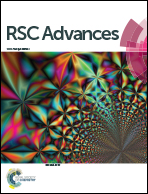Electrospinning of a PMA-co-PAA/FP biopolymer nanofiber: enhanced capability for immobilized horseradish peroxidase and its consequence for p-nitrophenol disposal
Abstract
In this study, a novel poly(methyl acrylate-co-acrylic acid)/feather polypeptide (PMA-co-PAA/FP) composite nanofiber, which was prepared via the electrospinning technique, was employed as a support for scalable immobilization of horseradish peroxidase (HRP) for the first time. The resulting PMA-co-PAA/FP–HRP can function as an active and recyclable nanobiocatalyst for p-nitrophenol (PNP) disposal, which shows high stability (still retaining ∼80% of the initial activity after 35 days), and robust activity (even under a broad pH value of 5–9 and temperature range of 20–60 °C). Furthermore, the conversion capability of the PNP with the immobilized HRP was significantly higher than its unimmobilized counterpart, showing a conversion ratio up to 85%. After 5 repeated cycles, the conversion capacity of the immobilized HRP decreased slightly and could still retain 70% residual activity. These results indicated that the PMA-co-PAA/FP–HRP possessed high stability and excellent reusability, suggesting that the electrospun PMA-co-PAA/FP nanofibrous membrane might have potential applications in enzyme immobilization, particularly for those related to environmental protection.


 Please wait while we load your content...
Please wait while we load your content...